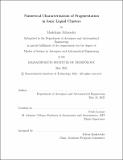Numerical Characterization of Fragmentation in Ionic Liquid Clusters
Author(s)
Schroeder, Madeleine
DownloadThesis PDF (5.348Mb)
Advisor
Lozano, Paulo
Terms of use
Metadata
Show full item recordAbstract
Ionic liquid ion sources are a promising technology that can be used for many applications from space propulsion to focused ion beam microetching. The variety of ionic liquids that can be synthesized enables the selection of desired beam properties for optimizing propulsion and focused ion beam performance. Ionic liquid ion sources produce ion beams by extracting single ions and metastable solvated ion clusters from the surface of the ionic liquid and accelerating them using an electric field generated by applying a voltage between a sharp tip and a plate with an aperture. The solvated ion clusters often fragment in the electric field region, reducing the specific impulse and efficiency for propulsion applications and increasing the beam spot size for focused ion beam applications by broadening the energy distribution of the beam.
Fragmentation behavior has previously been characterized in the region with no electric field. However, fragmentation under the effect of an electric field has not been investigated as experimental results are difficult to interpret for regions with electric fields. The goal of this work is to use various types of numerical methods to characterize fragmentation under the effect of an electric field. Molecular dynamics simulations are performed of various ionic liquid clusters under different conditions to determine the rate of fragmentation. These simulation results are also used to determine the different fragmentation pathways taken by each type of cluster, and the size of the different clusters as a result of energy content and electric field strength. Various physics-based models are compared to the molecular dynamics results with the goal of deriving a new model that accounts for the effect of the electric field on fragmentation. Approximate Bayesian computational methods are employed to infer the temperature of different ionic liquid cluster types and the percentage of the beam composed of each species by comparing simulated retarding potential analysis curves to experimental ones. Finally, the results of multi-scale N-body simulations are postprocessed and compared to experimental data. Results show remarkable agreement between N-body simulations using the fragmentation rates determined by molecular dynamics and experimental data.
Date issued
2021-06Department
Massachusetts Institute of Technology. Department of Aeronautics and AstronauticsPublisher
Massachusetts Institute of Technology